Report on Academic Skills and Child Labour in Global Supply Chains
VerifiedAdded on 2022/12/17
|8
|2248
|43
Report
AI Summary
This report comprises two main sections. The first section focuses on the development of academic skills, including time management, essay writing, research, and exam preparation. It reflects on the author's personal journey in improving these skills, outlining specific goals and strategies such as SMART goals, peer-to-peer learning, and utilizing personal development programs. The second section delves into the issue of child labor within supply chains. It defines child labor and examines its prevalence, particularly in the context of global supply chains. The report presents both the advantages and disadvantages of child labor, considering the perspectives of businesses and the children involved. The advantages include cost savings for businesses, while the disadvantages highlight the exploitation of children, interference with their education, and the potential for physical and mental harm. The report concludes with recommendations against child labor in supply chains, emphasizing the importance of education and ethical business practices.
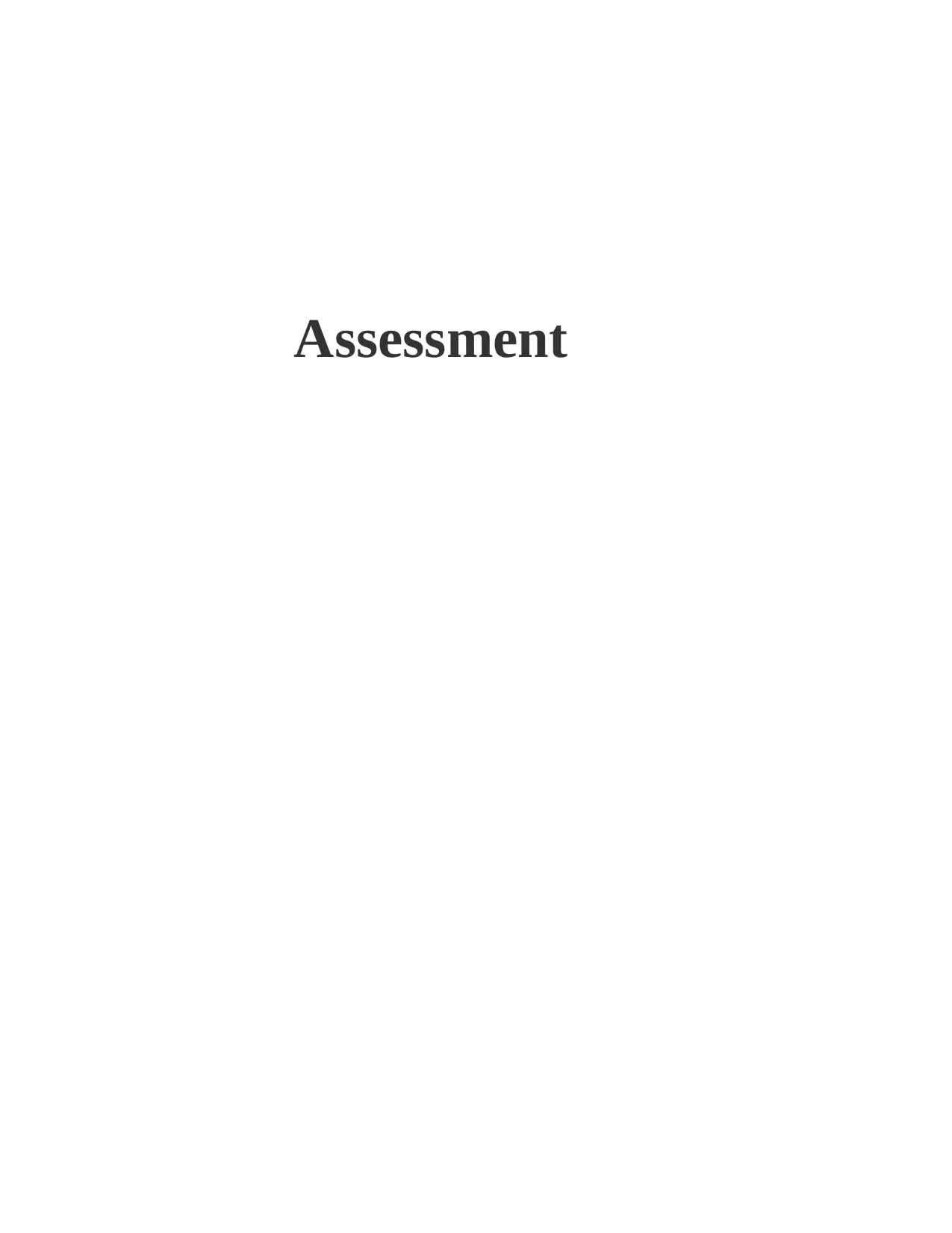
Assessment
Paraphrase This Document
Need a fresh take? Get an instant paraphrase of this document with our AI Paraphraser
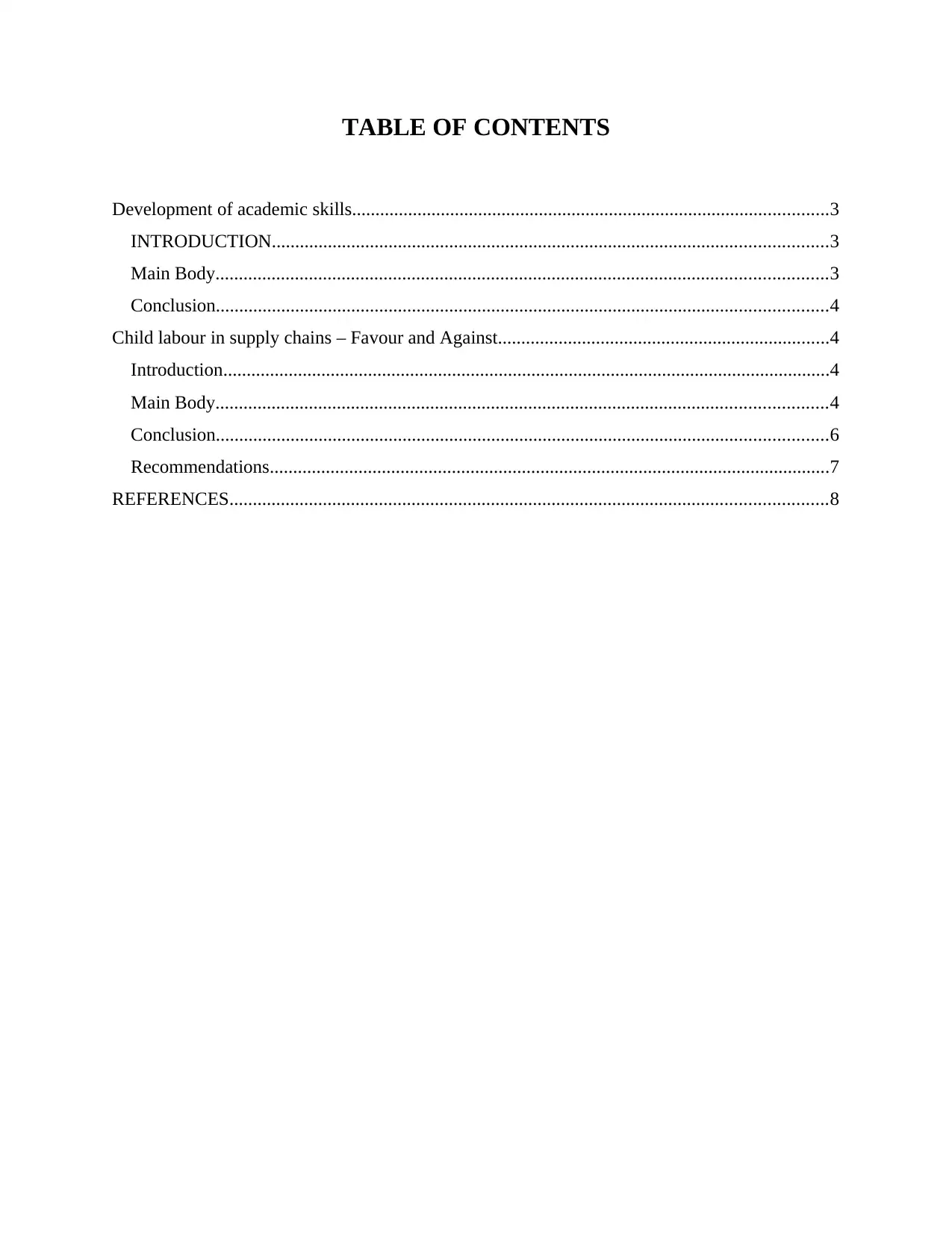
TABLE OF CONTENTS
Development of academic skills......................................................................................................3
INTRODUCTION.......................................................................................................................3
Main Body...................................................................................................................................3
Conclusion...................................................................................................................................4
Child labour in supply chains – Favour and Against.......................................................................4
Introduction..................................................................................................................................4
Main Body...................................................................................................................................4
Conclusion...................................................................................................................................6
Recommendations........................................................................................................................7
REFERENCES................................................................................................................................8
Development of academic skills......................................................................................................3
INTRODUCTION.......................................................................................................................3
Main Body...................................................................................................................................3
Conclusion...................................................................................................................................4
Child labour in supply chains – Favour and Against.......................................................................4
Introduction..................................................................................................................................4
Main Body...................................................................................................................................4
Conclusion...................................................................................................................................6
Recommendations........................................................................................................................7
REFERENCES................................................................................................................................8
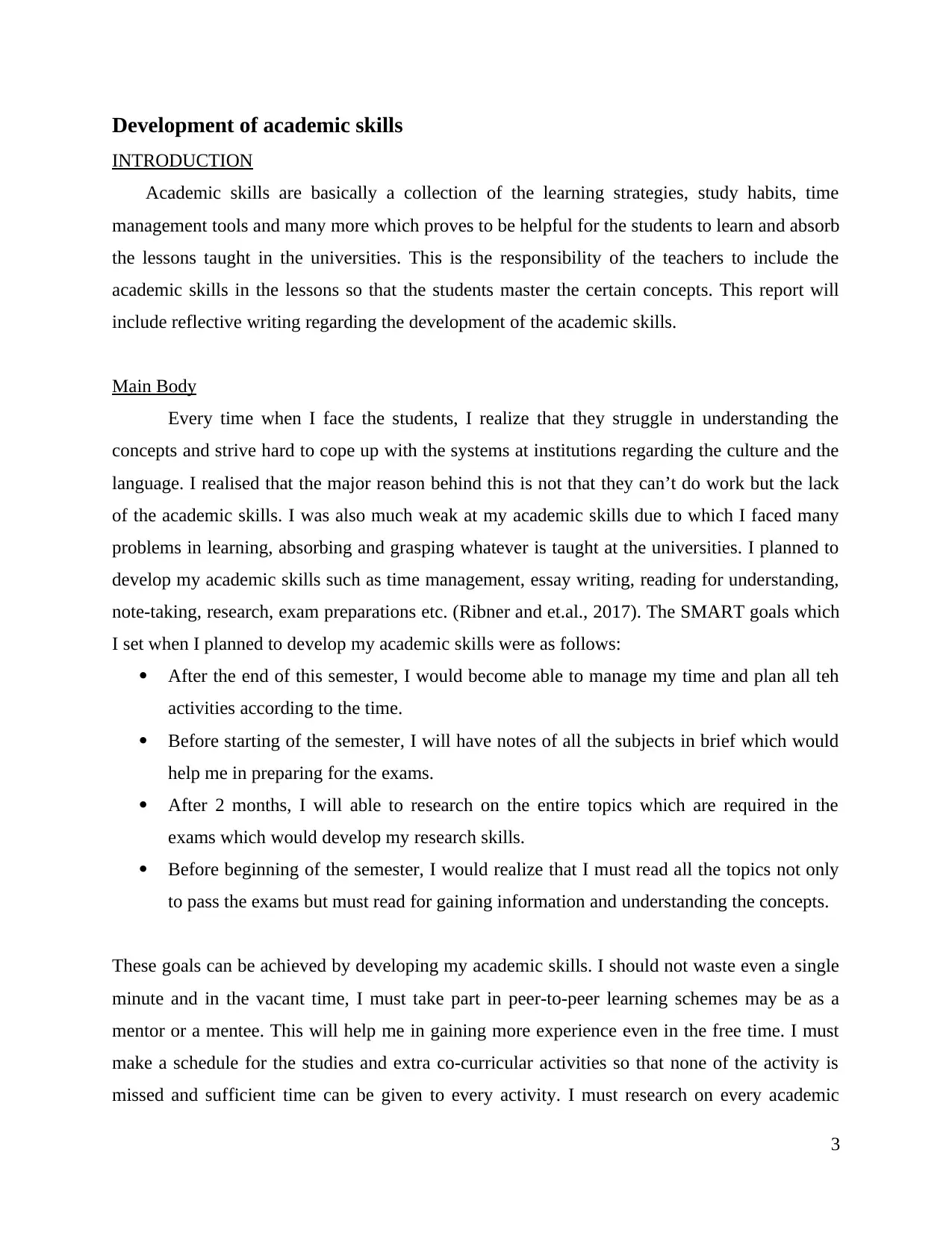
Development of academic skills
INTRODUCTION
Academic skills are basically a collection of the learning strategies, study habits, time
management tools and many more which proves to be helpful for the students to learn and absorb
the lessons taught in the universities. This is the responsibility of the teachers to include the
academic skills in the lessons so that the students master the certain concepts. This report will
include reflective writing regarding the development of the academic skills.
Main Body
Every time when I face the students, I realize that they struggle in understanding the
concepts and strive hard to cope up with the systems at institutions regarding the culture and the
language. I realised that the major reason behind this is not that they can’t do work but the lack
of the academic skills. I was also much weak at my academic skills due to which I faced many
problems in learning, absorbing and grasping whatever is taught at the universities. I planned to
develop my academic skills such as time management, essay writing, reading for understanding,
note-taking, research, exam preparations etc. (Ribner and et.al., 2017). The SMART goals which
I set when I planned to develop my academic skills were as follows:
After the end of this semester, I would become able to manage my time and plan all teh
activities according to the time.
Before starting of the semester, I will have notes of all the subjects in brief which would
help me in preparing for the exams.
After 2 months, I will able to research on the entire topics which are required in the
exams which would develop my research skills.
Before beginning of the semester, I would realize that I must read all the topics not only
to pass the exams but must read for gaining information and understanding the concepts.
These goals can be achieved by developing my academic skills. I should not waste even a single
minute and in the vacant time, I must take part in peer-to-peer learning schemes may be as a
mentor or a mentee. This will help me in gaining more experience even in the free time. I must
make a schedule for the studies and extra co-curricular activities so that none of the activity is
missed and sufficient time can be given to every activity. I must research on every academic
3
INTRODUCTION
Academic skills are basically a collection of the learning strategies, study habits, time
management tools and many more which proves to be helpful for the students to learn and absorb
the lessons taught in the universities. This is the responsibility of the teachers to include the
academic skills in the lessons so that the students master the certain concepts. This report will
include reflective writing regarding the development of the academic skills.
Main Body
Every time when I face the students, I realize that they struggle in understanding the
concepts and strive hard to cope up with the systems at institutions regarding the culture and the
language. I realised that the major reason behind this is not that they can’t do work but the lack
of the academic skills. I was also much weak at my academic skills due to which I faced many
problems in learning, absorbing and grasping whatever is taught at the universities. I planned to
develop my academic skills such as time management, essay writing, reading for understanding,
note-taking, research, exam preparations etc. (Ribner and et.al., 2017). The SMART goals which
I set when I planned to develop my academic skills were as follows:
After the end of this semester, I would become able to manage my time and plan all teh
activities according to the time.
Before starting of the semester, I will have notes of all the subjects in brief which would
help me in preparing for the exams.
After 2 months, I will able to research on the entire topics which are required in the
exams which would develop my research skills.
Before beginning of the semester, I would realize that I must read all the topics not only
to pass the exams but must read for gaining information and understanding the concepts.
These goals can be achieved by developing my academic skills. I should not waste even a single
minute and in the vacant time, I must take part in peer-to-peer learning schemes may be as a
mentor or a mentee. This will help me in gaining more experience even in the free time. I must
make a schedule for the studies and extra co-curricular activities so that none of the activity is
missed and sufficient time can be given to every activity. I must research on every academic
3
⊘ This is a preview!⊘
Do you want full access?
Subscribe today to unlock all pages.

Trusted by 1+ million students worldwide
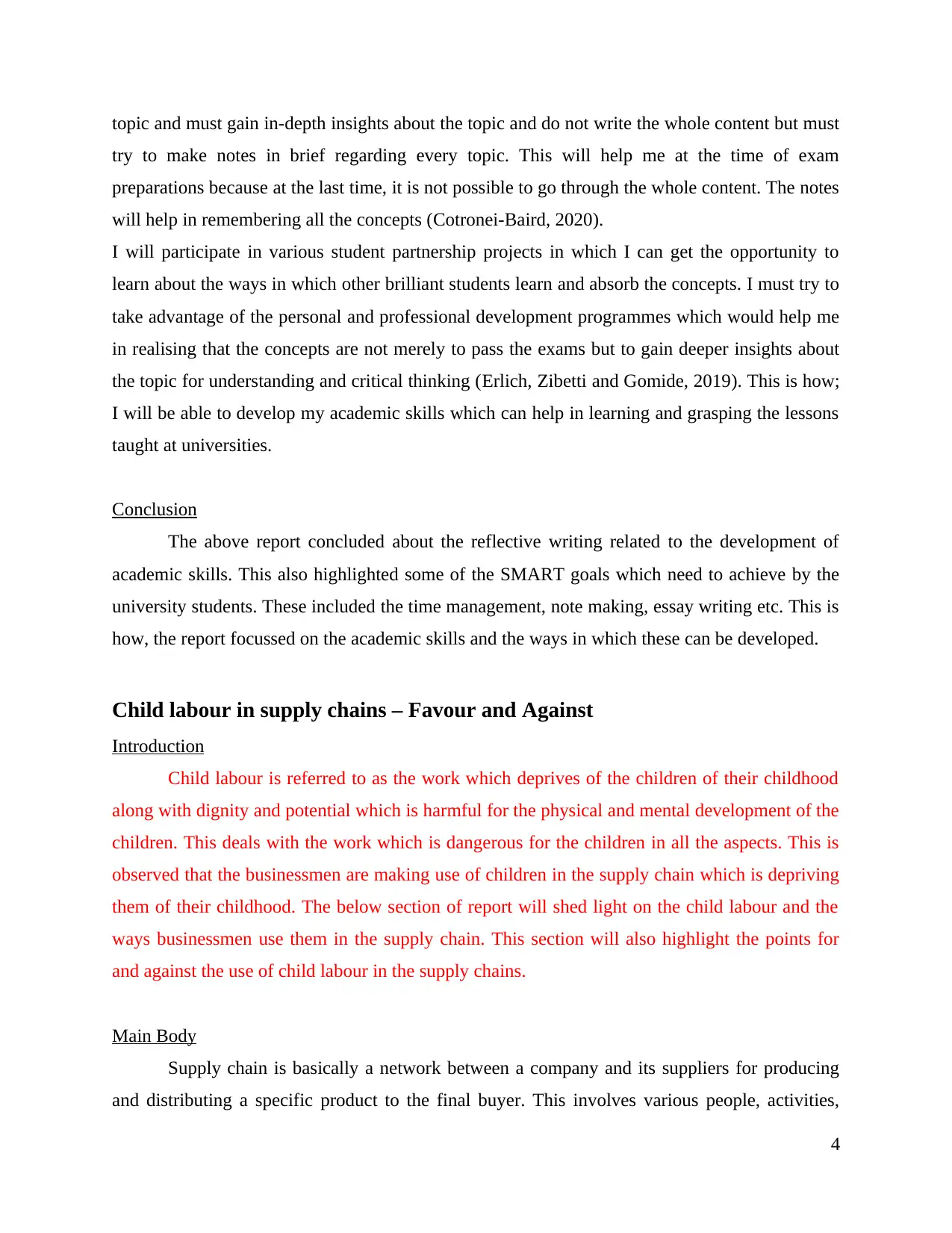
topic and must gain in-depth insights about the topic and do not write the whole content but must
try to make notes in brief regarding every topic. This will help me at the time of exam
preparations because at the last time, it is not possible to go through the whole content. The notes
will help in remembering all the concepts (Cotronei-Baird, 2020).
I will participate in various student partnership projects in which I can get the opportunity to
learn about the ways in which other brilliant students learn and absorb the concepts. I must try to
take advantage of the personal and professional development programmes which would help me
in realising that the concepts are not merely to pass the exams but to gain deeper insights about
the topic for understanding and critical thinking (Erlich, Zibetti and Gomide, 2019). This is how;
I will be able to develop my academic skills which can help in learning and grasping the lessons
taught at universities.
Conclusion
The above report concluded about the reflective writing related to the development of
academic skills. This also highlighted some of the SMART goals which need to achieve by the
university students. These included the time management, note making, essay writing etc. This is
how, the report focussed on the academic skills and the ways in which these can be developed.
Child labour in supply chains – Favour and Against
Introduction
Child labour is referred to as the work which deprives of the children of their childhood
along with dignity and potential which is harmful for the physical and mental development of the
children. This deals with the work which is dangerous for the children in all the aspects. This is
observed that the businessmen are making use of children in the supply chain which is depriving
them of their childhood. The below section of report will shed light on the child labour and the
ways businessmen use them in the supply chain. This section will also highlight the points for
and against the use of child labour in the supply chains.
Main Body
Supply chain is basically a network between a company and its suppliers for producing
and distributing a specific product to the final buyer. This involves various people, activities,
4
try to make notes in brief regarding every topic. This will help me at the time of exam
preparations because at the last time, it is not possible to go through the whole content. The notes
will help in remembering all the concepts (Cotronei-Baird, 2020).
I will participate in various student partnership projects in which I can get the opportunity to
learn about the ways in which other brilliant students learn and absorb the concepts. I must try to
take advantage of the personal and professional development programmes which would help me
in realising that the concepts are not merely to pass the exams but to gain deeper insights about
the topic for understanding and critical thinking (Erlich, Zibetti and Gomide, 2019). This is how;
I will be able to develop my academic skills which can help in learning and grasping the lessons
taught at universities.
Conclusion
The above report concluded about the reflective writing related to the development of
academic skills. This also highlighted some of the SMART goals which need to achieve by the
university students. These included the time management, note making, essay writing etc. This is
how, the report focussed on the academic skills and the ways in which these can be developed.
Child labour in supply chains – Favour and Against
Introduction
Child labour is referred to as the work which deprives of the children of their childhood
along with dignity and potential which is harmful for the physical and mental development of the
children. This deals with the work which is dangerous for the children in all the aspects. This is
observed that the businessmen are making use of children in the supply chain which is depriving
them of their childhood. The below section of report will shed light on the child labour and the
ways businessmen use them in the supply chain. This section will also highlight the points for
and against the use of child labour in the supply chains.
Main Body
Supply chain is basically a network between a company and its suppliers for producing
and distributing a specific product to the final buyer. This involves various people, activities,
4
Paraphrase This Document
Need a fresh take? Get an instant paraphrase of this document with our AI Paraphraser
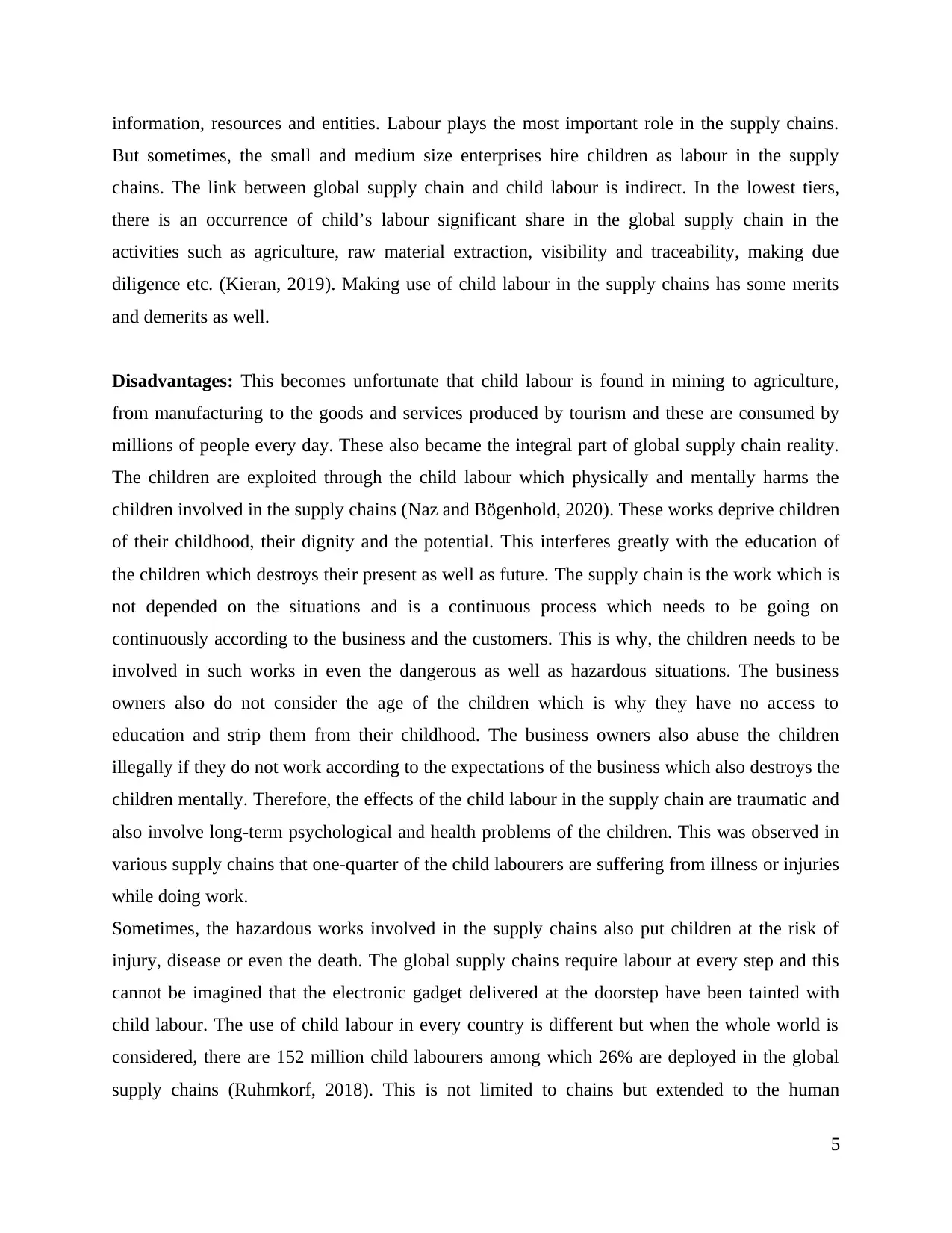
information, resources and entities. Labour plays the most important role in the supply chains.
But sometimes, the small and medium size enterprises hire children as labour in the supply
chains. The link between global supply chain and child labour is indirect. In the lowest tiers,
there is an occurrence of child’s labour significant share in the global supply chain in the
activities such as agriculture, raw material extraction, visibility and traceability, making due
diligence etc. (Kieran, 2019). Making use of child labour in the supply chains has some merits
and demerits as well.
Disadvantages: This becomes unfortunate that child labour is found in mining to agriculture,
from manufacturing to the goods and services produced by tourism and these are consumed by
millions of people every day. These also became the integral part of global supply chain reality.
The children are exploited through the child labour which physically and mentally harms the
children involved in the supply chains (Naz and Bögenhold, 2020). These works deprive children
of their childhood, their dignity and the potential. This interferes greatly with the education of
the children which destroys their present as well as future. The supply chain is the work which is
not depended on the situations and is a continuous process which needs to be going on
continuously according to the business and the customers. This is why, the children needs to be
involved in such works in even the dangerous as well as hazardous situations. The business
owners also do not consider the age of the children which is why they have no access to
education and strip them from their childhood. The business owners also abuse the children
illegally if they do not work according to the expectations of the business which also destroys the
children mentally. Therefore, the effects of the child labour in the supply chain are traumatic and
also involve long-term psychological and health problems of the children. This was observed in
various supply chains that one-quarter of the child labourers are suffering from illness or injuries
while doing work.
Sometimes, the hazardous works involved in the supply chains also put children at the risk of
injury, disease or even the death. The global supply chains require labour at every step and this
cannot be imagined that the electronic gadget delivered at the doorstep have been tainted with
child labour. The use of child labour in every country is different but when the whole world is
considered, there are 152 million child labourers among which 26% are deployed in the global
supply chains (Ruhmkorf, 2018). This is not limited to chains but extended to the human
5
But sometimes, the small and medium size enterprises hire children as labour in the supply
chains. The link between global supply chain and child labour is indirect. In the lowest tiers,
there is an occurrence of child’s labour significant share in the global supply chain in the
activities such as agriculture, raw material extraction, visibility and traceability, making due
diligence etc. (Kieran, 2019). Making use of child labour in the supply chains has some merits
and demerits as well.
Disadvantages: This becomes unfortunate that child labour is found in mining to agriculture,
from manufacturing to the goods and services produced by tourism and these are consumed by
millions of people every day. These also became the integral part of global supply chain reality.
The children are exploited through the child labour which physically and mentally harms the
children involved in the supply chains (Naz and Bögenhold, 2020). These works deprive children
of their childhood, their dignity and the potential. This interferes greatly with the education of
the children which destroys their present as well as future. The supply chain is the work which is
not depended on the situations and is a continuous process which needs to be going on
continuously according to the business and the customers. This is why, the children needs to be
involved in such works in even the dangerous as well as hazardous situations. The business
owners also do not consider the age of the children which is why they have no access to
education and strip them from their childhood. The business owners also abuse the children
illegally if they do not work according to the expectations of the business which also destroys the
children mentally. Therefore, the effects of the child labour in the supply chain are traumatic and
also involve long-term psychological and health problems of the children. This was observed in
various supply chains that one-quarter of the child labourers are suffering from illness or injuries
while doing work.
Sometimes, the hazardous works involved in the supply chains also put children at the risk of
injury, disease or even the death. The global supply chains require labour at every step and this
cannot be imagined that the electronic gadget delivered at the doorstep have been tainted with
child labour. The use of child labour in every country is different but when the whole world is
considered, there are 152 million child labourers among which 26% are deployed in the global
supply chains (Ruhmkorf, 2018). This is not limited to chains but extended to the human
5
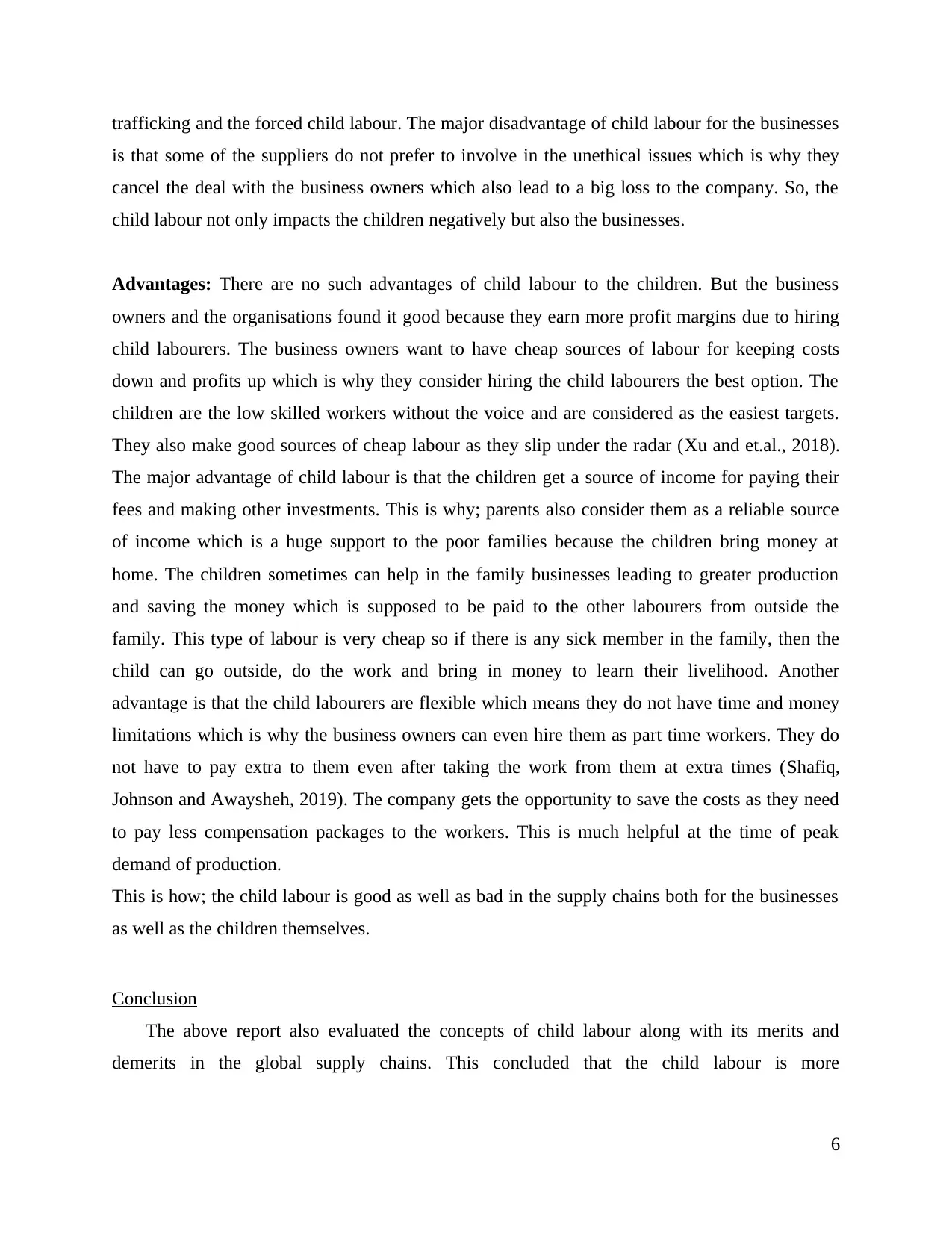
trafficking and the forced child labour. The major disadvantage of child labour for the businesses
is that some of the suppliers do not prefer to involve in the unethical issues which is why they
cancel the deal with the business owners which also lead to a big loss to the company. So, the
child labour not only impacts the children negatively but also the businesses.
Advantages: There are no such advantages of child labour to the children. But the business
owners and the organisations found it good because they earn more profit margins due to hiring
child labourers. The business owners want to have cheap sources of labour for keeping costs
down and profits up which is why they consider hiring the child labourers the best option. The
children are the low skilled workers without the voice and are considered as the easiest targets.
They also make good sources of cheap labour as they slip under the radar (Xu and et.al., 2018).
The major advantage of child labour is that the children get a source of income for paying their
fees and making other investments. This is why; parents also consider them as a reliable source
of income which is a huge support to the poor families because the children bring money at
home. The children sometimes can help in the family businesses leading to greater production
and saving the money which is supposed to be paid to the other labourers from outside the
family. This type of labour is very cheap so if there is any sick member in the family, then the
child can go outside, do the work and bring in money to learn their livelihood. Another
advantage is that the child labourers are flexible which means they do not have time and money
limitations which is why the business owners can even hire them as part time workers. They do
not have to pay extra to them even after taking the work from them at extra times (Shafiq,
Johnson and Awaysheh, 2019). The company gets the opportunity to save the costs as they need
to pay less compensation packages to the workers. This is much helpful at the time of peak
demand of production.
This is how; the child labour is good as well as bad in the supply chains both for the businesses
as well as the children themselves.
Conclusion
The above report also evaluated the concepts of child labour along with its merits and
demerits in the global supply chains. This concluded that the child labour is more
6
is that some of the suppliers do not prefer to involve in the unethical issues which is why they
cancel the deal with the business owners which also lead to a big loss to the company. So, the
child labour not only impacts the children negatively but also the businesses.
Advantages: There are no such advantages of child labour to the children. But the business
owners and the organisations found it good because they earn more profit margins due to hiring
child labourers. The business owners want to have cheap sources of labour for keeping costs
down and profits up which is why they consider hiring the child labourers the best option. The
children are the low skilled workers without the voice and are considered as the easiest targets.
They also make good sources of cheap labour as they slip under the radar (Xu and et.al., 2018).
The major advantage of child labour is that the children get a source of income for paying their
fees and making other investments. This is why; parents also consider them as a reliable source
of income which is a huge support to the poor families because the children bring money at
home. The children sometimes can help in the family businesses leading to greater production
and saving the money which is supposed to be paid to the other labourers from outside the
family. This type of labour is very cheap so if there is any sick member in the family, then the
child can go outside, do the work and bring in money to learn their livelihood. Another
advantage is that the child labourers are flexible which means they do not have time and money
limitations which is why the business owners can even hire them as part time workers. They do
not have to pay extra to them even after taking the work from them at extra times (Shafiq,
Johnson and Awaysheh, 2019). The company gets the opportunity to save the costs as they need
to pay less compensation packages to the workers. This is much helpful at the time of peak
demand of production.
This is how; the child labour is good as well as bad in the supply chains both for the businesses
as well as the children themselves.
Conclusion
The above report also evaluated the concepts of child labour along with its merits and
demerits in the global supply chains. This concluded that the child labour is more
6
⊘ This is a preview!⊘
Do you want full access?
Subscribe today to unlock all pages.

Trusted by 1+ million students worldwide
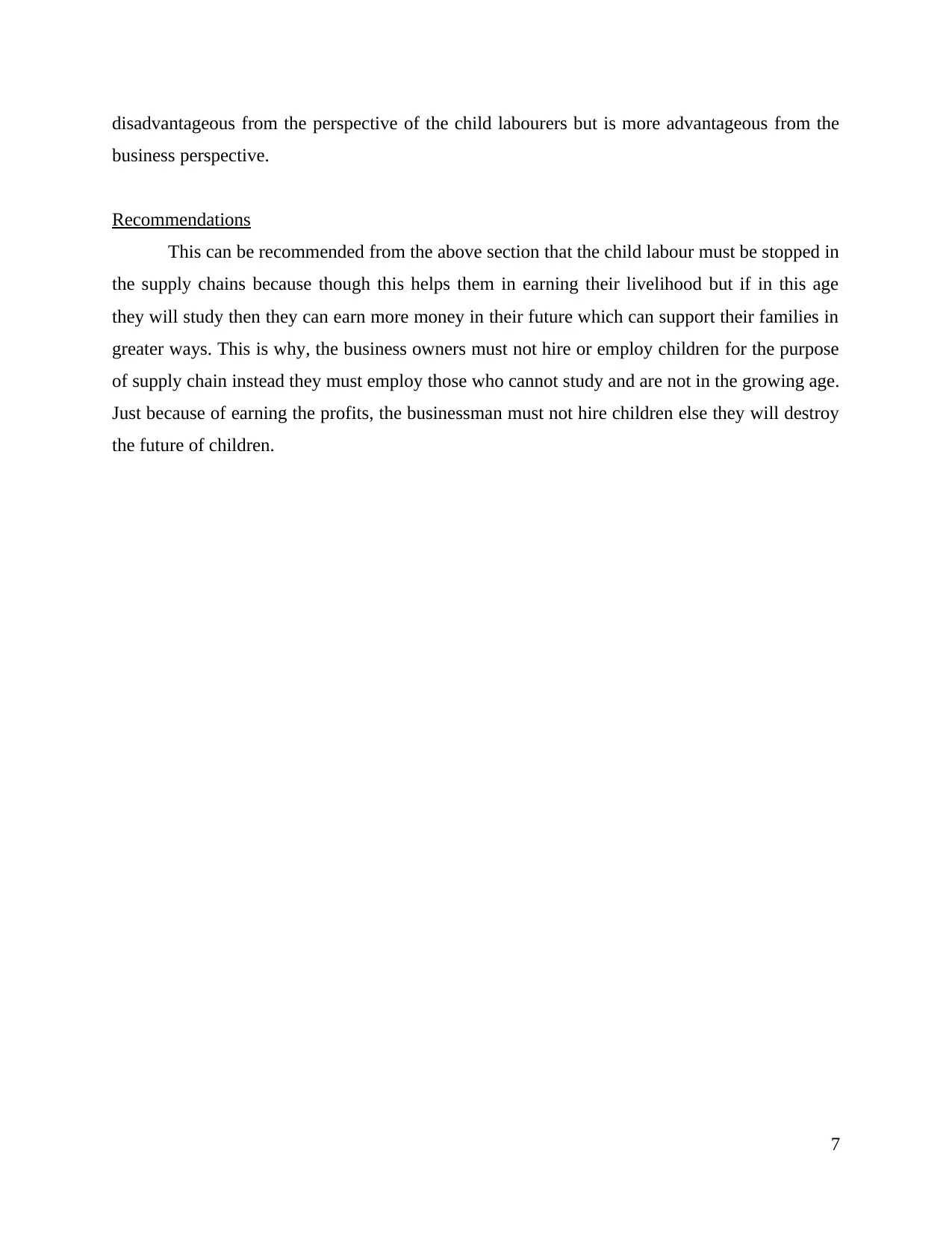
disadvantageous from the perspective of the child labourers but is more advantageous from the
business perspective.
Recommendations
This can be recommended from the above section that the child labour must be stopped in
the supply chains because though this helps them in earning their livelihood but if in this age
they will study then they can earn more money in their future which can support their families in
greater ways. This is why, the business owners must not hire or employ children for the purpose
of supply chain instead they must employ those who cannot study and are not in the growing age.
Just because of earning the profits, the businessman must not hire children else they will destroy
the future of children.
7
business perspective.
Recommendations
This can be recommended from the above section that the child labour must be stopped in
the supply chains because though this helps them in earning their livelihood but if in this age
they will study then they can earn more money in their future which can support their families in
greater ways. This is why, the business owners must not hire or employ children for the purpose
of supply chain instead they must employ those who cannot study and are not in the growing age.
Just because of earning the profits, the businessman must not hire children else they will destroy
the future of children.
7
Paraphrase This Document
Need a fresh take? Get an instant paraphrase of this document with our AI Paraphraser
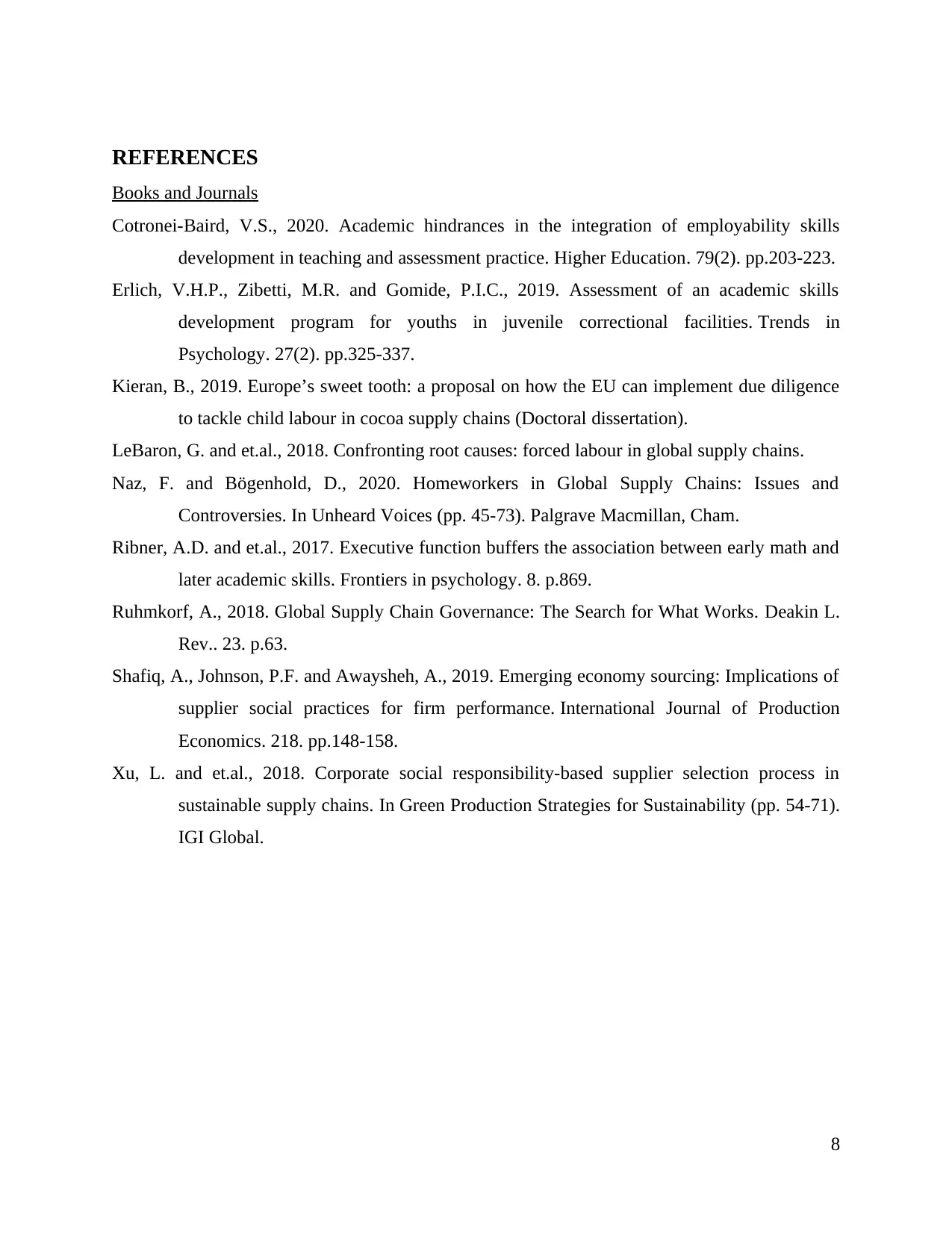
REFERENCES
Books and Journals
Cotronei-Baird, V.S., 2020. Academic hindrances in the integration of employability skills
development in teaching and assessment practice. Higher Education. 79(2). pp.203-223.
Erlich, V.H.P., Zibetti, M.R. and Gomide, P.I.C., 2019. Assessment of an academic skills
development program for youths in juvenile correctional facilities. Trends in
Psychology. 27(2). pp.325-337.
Kieran, B., 2019. Europe’s sweet tooth: a proposal on how the EU can implement due diligence
to tackle child labour in cocoa supply chains (Doctoral dissertation).
LeBaron, G. and et.al., 2018. Confronting root causes: forced labour in global supply chains.
Naz, F. and Bögenhold, D., 2020. Homeworkers in Global Supply Chains: Issues and
Controversies. In Unheard Voices (pp. 45-73). Palgrave Macmillan, Cham.
Ribner, A.D. and et.al., 2017. Executive function buffers the association between early math and
later academic skills. Frontiers in psychology. 8. p.869.
Ruhmkorf, A., 2018. Global Supply Chain Governance: The Search for What Works. Deakin L.
Rev.. 23. p.63.
Shafiq, A., Johnson, P.F. and Awaysheh, A., 2019. Emerging economy sourcing: Implications of
supplier social practices for firm performance. International Journal of Production
Economics. 218. pp.148-158.
Xu, L. and et.al., 2018. Corporate social responsibility-based supplier selection process in
sustainable supply chains. In Green Production Strategies for Sustainability (pp. 54-71).
IGI Global.
8
Books and Journals
Cotronei-Baird, V.S., 2020. Academic hindrances in the integration of employability skills
development in teaching and assessment practice. Higher Education. 79(2). pp.203-223.
Erlich, V.H.P., Zibetti, M.R. and Gomide, P.I.C., 2019. Assessment of an academic skills
development program for youths in juvenile correctional facilities. Trends in
Psychology. 27(2). pp.325-337.
Kieran, B., 2019. Europe’s sweet tooth: a proposal on how the EU can implement due diligence
to tackle child labour in cocoa supply chains (Doctoral dissertation).
LeBaron, G. and et.al., 2018. Confronting root causes: forced labour in global supply chains.
Naz, F. and Bögenhold, D., 2020. Homeworkers in Global Supply Chains: Issues and
Controversies. In Unheard Voices (pp. 45-73). Palgrave Macmillan, Cham.
Ribner, A.D. and et.al., 2017. Executive function buffers the association between early math and
later academic skills. Frontiers in psychology. 8. p.869.
Ruhmkorf, A., 2018. Global Supply Chain Governance: The Search for What Works. Deakin L.
Rev.. 23. p.63.
Shafiq, A., Johnson, P.F. and Awaysheh, A., 2019. Emerging economy sourcing: Implications of
supplier social practices for firm performance. International Journal of Production
Economics. 218. pp.148-158.
Xu, L. and et.al., 2018. Corporate social responsibility-based supplier selection process in
sustainable supply chains. In Green Production Strategies for Sustainability (pp. 54-71).
IGI Global.
8
1 out of 8
Related Documents
Your All-in-One AI-Powered Toolkit for Academic Success.
+13062052269
info@desklib.com
Available 24*7 on WhatsApp / Email
![[object Object]](/_next/static/media/star-bottom.7253800d.svg)
Unlock your academic potential
Copyright © 2020–2025 A2Z Services. All Rights Reserved. Developed and managed by ZUCOL.




